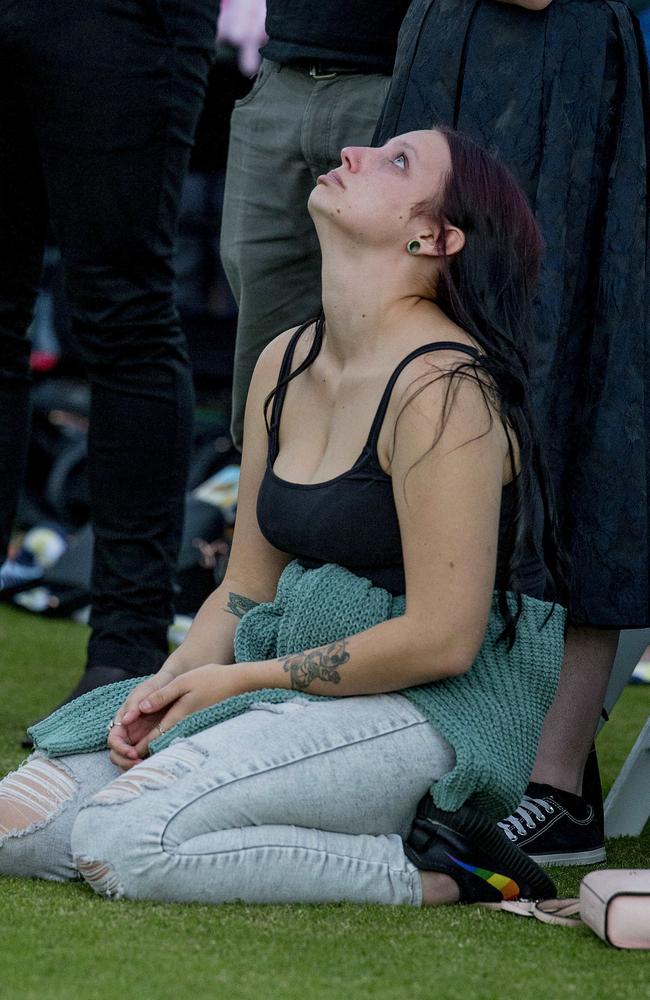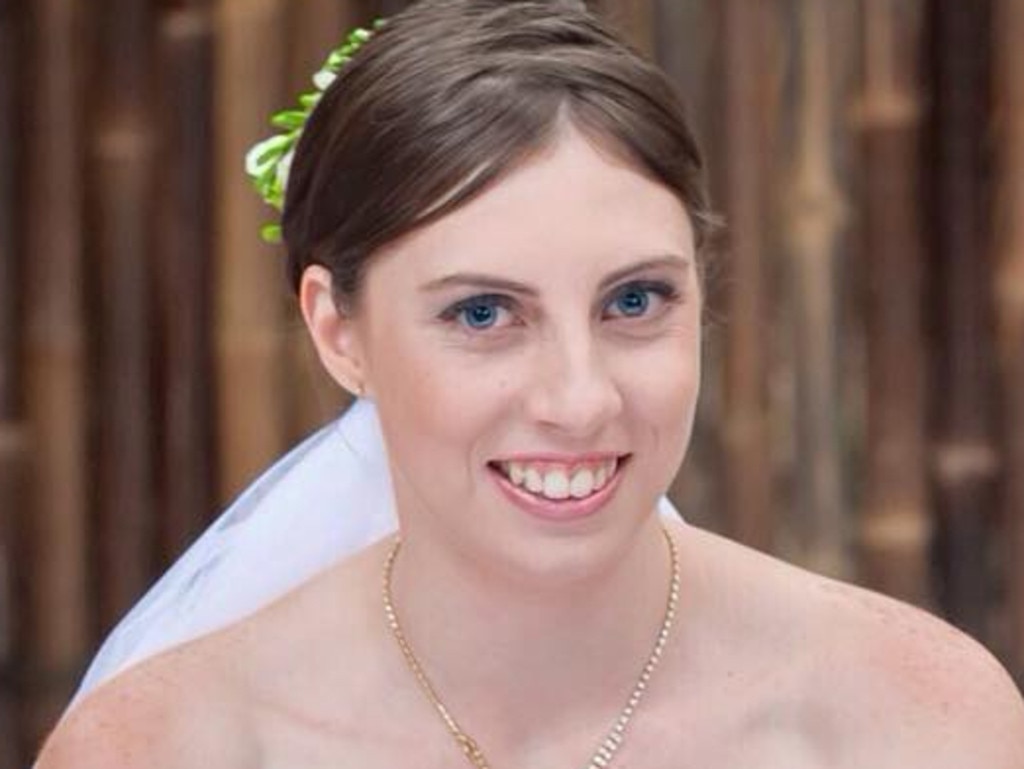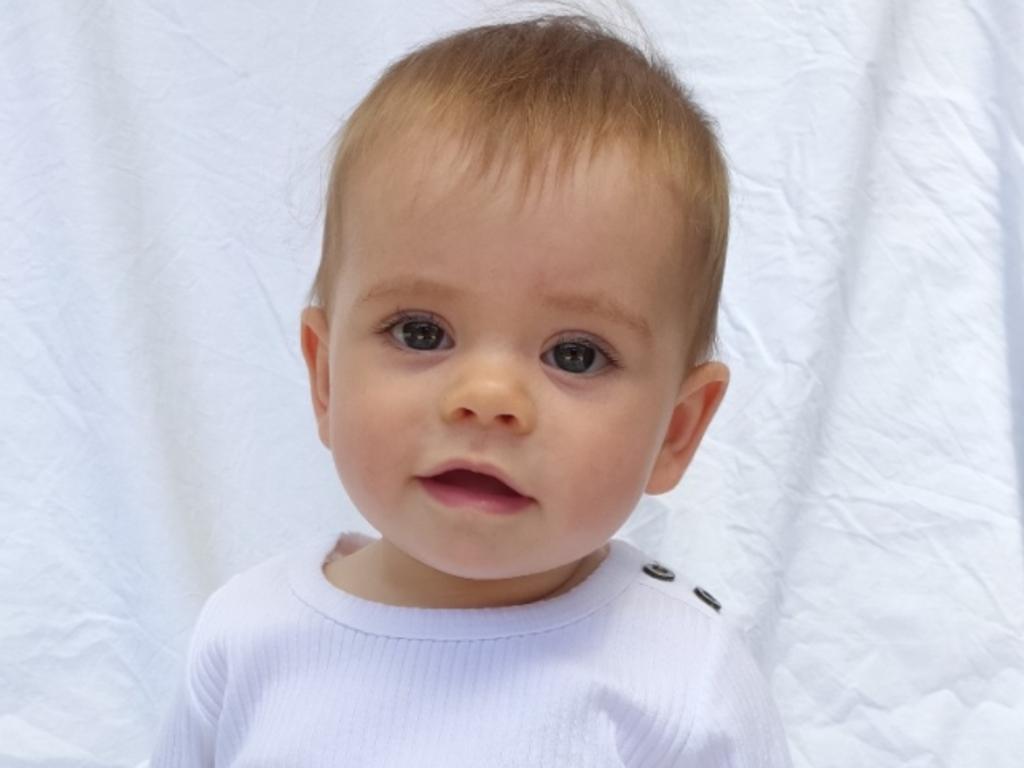Domestic and family violence is Australia’s national shame
A woman on her knees staring at the sky, lost in grief. It’s a scene that is difficult to look at – but that doesn’t mean we should look away.
Kelly Wilkinson’s sister Natalie is immersed in grief, kneeling at her sibling’s memorial among friends, family members and complete strangers, and staring towards the heavens for a sign.
Her moment of mourning is a tiny glimpse into the impact felt by loved ones shattered by the horrific, violent last moments of the young Queensland mother’s life.
Ms Wilkinson had been left to die in the family’s Gold Coast backyard on April 20 after allegedly being set alight by her estranged partner in the presence of her three young children, all aged under nine.
Knives, a melted plastic jerry can and a duffel bag containing rope were found nearby – grim clues as to what may have unfolded in the early hours of Ms Wilkinson’s last day on earth.
Her estranged partner, Brian Johnston, who is still in an induced coma after being found with burns on his hands and in his airways, has been charged with her murder.

The grisly details of her story have again thrust into the national spotlight the issue of family and domestic violence.
But the sad and undeniable reality is that violence in the family home is an everyday experience in Australia with often deadly outcomes.
On average, one woman a week is murdered by her current or former partner.
Almost 10 women a day are hospitalised for assault injuries at the hands of a spouse or domestic partner.
Every day in May, as part of Domestic and Family Violence Awareness Month, news.com.au will tell the stories behind those shocking statistics.
‘I am scared for my children’s life’ – Kelly Wilkinson
Queensland Police Assistant Commissioner Brian Codd pulled no punches when discussing the circumstances of Ms Wilkinson’s death.
“She’s been killed, we will allege, in horrific circumstances,” he said, before alluding to claims the 27-year-old had been in regular contact with police about the man who allegedly killed her.
“Somewhere along the line, she had engaged with the system, with us. I think it’s important that we examine to what extent it is a systemic failure.
“We haven’t come to that conclusion yet, but there’s certainly, ultimately it’s a failure. A woman has died.
“I’d be loath to allow women to think for one moment that the stories are (not) listened to.”
Speaking with reporters last week, Ms Wilkinson’s sisters said the mother-of-three had been the victim of ongoing abuse.
“She came forward and said, ‘I am scared for my life, I am scared for my children’s life. We are not safe,’” Ms Wilkinson’s sister Danielle said.
“She was saying this to the police over and over and nothing was done. There was no support, there was no safeguard.”
Sherele Moody, who has documented the violent deaths of some 2400 women and children in Australia for the RED HEART Campaign, told news.com.au many women’s deaths were “entirely foreseeable and preventable”.

“It is fairly evident from the number of women and children killed over the past decade, that intimate partner and domestic violence is still far too common in Australia,” she said.
“It seems, no matter how many times we focus attention on this national shame, very few perpetrators are getting the message that they need to take control of their own actions before they end another person’s life.”
She said Australia prioritises the wrong thing and fails to treat domestic and family violence as seriously as it deserves to be treated.
“In our country, we spend billions of dollars on terrorism, which impacts so few people and kills even less, but our governments refuse to put the same level of funding into the real form of terrorism that’s killing one woman a week, one child a fortnight and one man a month.
“Throw in a family law system that prioritises abusive perpetrators’ rights to parent over the safety of children and a legal system that repeatedly bails, refuses to jail and refuses to track domestic violence perpetrators, and you end up with situations that end in the murder of defenceless children like little Kobi Shepherdson.”
Kobi, just nine months old, was plunged to her death last month when her father Henry Shepherdson, 38, jumped from the Whispering Wall reservoir in South Australia with her strapped to his chest.

Women killed trying to leave relationships
The stories are shocking, but we cannot look away.
According to Our Watch, Australia’s leader in the primary prevention of violence against women and their children, one-in-three women in Australia has experienced physical violence since the age of 15 and one-in-four women in Australia has experienced physical or sexual violence by a current or former partner.
The organisation says Australian women are nearly three times more likely than men to experience violence from an intimate partner.
Our Watch CEO Patty Kinnersly said it is often the case that women are murdered in Australia simply for trying to escape.
“Shockingly, one woman on average is killed nearly every week in Australia by a male partner or ex-partner – often while she is trying to leave the relationship,” she said.
“Most of these murders are the ultimate act in a longer history of domestic violence.”
Ms Kinnersly said family and domestic violence can be stopped.
“The first driver is the condoning of violence against women – such as when we excuse, downplay or trivialise violence or victim-blame.
“The second driver is men’s control of decision making and limits to women’s independence – which is the idea that men are responsible for holding the power in decision-making whether that be leadership roles across a workplace, or in politics or in a household.
“The third driver is stereotyped constructions of masculinity and femininity, such as that men should be the ‘breadwinner’ and women should be the main carers for children.
“The final driver is male peer relations that emphasise aggression and disrespect towards women – which is the way men can be hostile or aggressive towards women when in groups in order to look more ‘manly’.”




